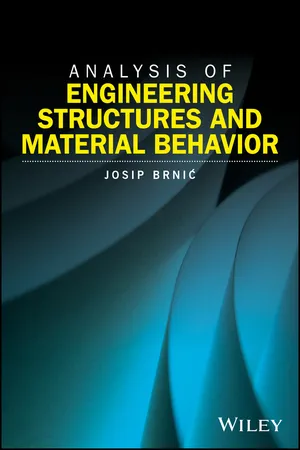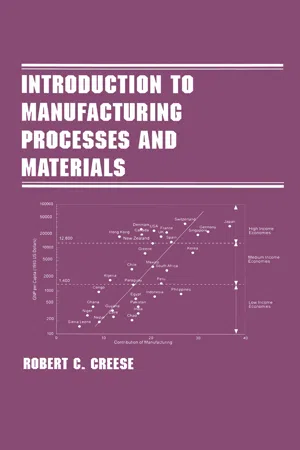Technology & Engineering
Isotropic Hardening
Isotropic hardening is a type of material hardening that occurs when a metal is subjected to plastic deformation. It is characterized by the uniform distribution of residual stresses throughout the material, which results in an increase in the yield strength of the metal. This type of hardening is commonly observed in metals that have undergone cold working or rolling.
Written by Perlego with AI-assistance
Related key terms
Related key terms
1 of 4
Related key terms
1 of 3
3 Key excerpts on "Isotropic Hardening"
- eBook - ePub
Multiscale Modeling of Heterogenous Materials
From Microstructure to Macro-Scale Properties
- Oana Cazacu, Oana Cazacu(Authors)
- 2013(Publication Date)
- Wiley-ISTE(Publisher)
[5.6] for an improved representation of the anisotropy (see [PLU 08]).5.4. Modeling anIsotropic Hardening due to texture evolution
Regardless of the shape of the yield surface, strain hardening can be isotropic or anisotropic. The former corresponds to an expansion of the yield surface without distortion. Any other type of hardening is anisotropic and leads to different properties in different directions after deformation, even if the material is initially isotropic. Pure translation of the initial yield surface could be described by the classic linear kinematic hardening laws (see [CHA 86]). To model the smooth elastic-plastic transition upon reverse loading more accurately, multi-surface models as well as non-linear kinematic hardening models have been proposed. Such models, reviewed by [LI 03], may capture hardening anisotropy associated with cyclic loading (e.g. Bauschinger effects) but not anIsotropic Hardening under monotonic strain paths.Modeling hardening in hexagonal metals is even more challenging since the hardening rate is strongly dependent not only on the loading path but also on the sense of loading (see [LOU 07]). To describe with accuracy the evolution of the yield locus, it is imperative to account for the most important sources of anisotropy in the given material: slip and/or twinning activity, substructure evolution at the grain level and texture development during deformation. In crystal plasticity models (see e.g. [DAW 03]), the available slip/twinning systems, their critical shear stresses and the distribution of lattice orientations in a given polycrystal are taken into account explicitly. Therefore, lattice rotations and the associated anisotropy evolution result directly from the use of a suitable homogenization scheme (e.g. a Taylor model or a self-consistent model). Recently, the application of crystal plasticity models to hcp metals and their use in finite element (FE) analyses have received much attention. Models that account for both slip and twinning activity and employ Taylor (e.g. [WU 07]) or self-consistent ([e.g. [LEB 93]) averaging schemes to predict the aggregate behavior have been proposed. For example, [STA 03] neglects hardening but accounts for the transgranular effects on plastic deformation observed in magnesium alloys. [WU 07] focused on the characterization of the strain-hardening behavior of high-purity titanium at room temperature and the development of slip-hardening and twin-hardening functions. These laws were used to simulate the stress-strain response and texture evolution for monotonic loading (uniaxial compression and simple shear). However, no attempt was made to predict the final deformed shape of the specimens or to perform benchmark simulations of more complex monotonic loadings such as bending. In [KAS 01], a self-consistent viscoplastic model linked to the explicit FE code EPIC has been successfully used for describing the deformation of pure zirconium with a strong initial texture under quasi-static monotonic loading. A polycrystalline aggregate was associated with each FE integration point. Such FE calculations have the advantage of keeping track of texture evolution. However, they are computationally very intensive and, thus, their applicability is limited to problems that do not require a fine spatial resolution. - Josip Brnic(Author)
- 2018(Publication Date)
- Wiley(Publisher)
Here:, …..,, ……, …. 7.3 Isotropic Materials Consider an elastic engineering element made of an isotropic material. An isotropic material is characterized by the fact that its elastic and mechanical properties do not depend on the direction (straight line) across a considered point. Since an infinite number of straight lines can pass through the point, this corresponds to an infinite number of coordinate systems as well as to an infinite number of planes through the same point. Due to the isotropy, the elastic constants (elastic coefficients) are invariants, that is, they do not change when the direction is changed. This implies that isotropic materials possess an infinite number of planes of material symmetry through a considered point. As stated, the elastic and mechanical properties of isotropic materials do not depend on the direction (straight line) across a considered point; this means that the elastic coefficients are invariant under arbitrary rotation of the coordinate system [2, 6–7]. This implies that the coefficients C ij in Equation (7.12) in the x i coordinate system (x, y, z) remain unchanged (invariants due to isotropy) in the new, rotated x φ system (,,). So, in the new system, we can write: (7.14) and, due to the isotropy: (7.15) To find the structure of the matrix C ij, consider its behavior during the process of transformation (in this case it is rotation) of the coordinate system. Transformation of the tensor matrix (stress tensor) is prescribed by Equation (2.55) : (7.16) where [ a ] is the transformation matrix, while is the stress tensor in the new, rotated () coordinate system and [ σ ] is the stress tensor in the old, original (x, y) coordinate system. Assume that the x–y system (or the plane x–y, or, for short, the x i system) rotates for angle φ around the “z” axis which remains unchanged ; that is, angle φ is the angle between the x i and the x α system- Robert Creese(Author)
- 2017(Publication Date)
- CRC Press(Publisher)
Dispersion hardening is a more general term than age hardening: The second phase is finely dispersed throughout the primary phase by means other than precipitation from a supersaturated solid solution. This can be done by mechanically mixing the second phase and using powder metallurgy processes, internal oxidation of particles, or other means. Carbide tools are formed by the powder metallurgy process, and this is dispersion hardening rather than age hardening; but the structure is similar to that of an age-hardened structure.4.6 Summary
Material properties comprise a critical parameter needed for the design of manufactured products. There are four methods generally used to increase the material properties of metals: alloying, grain size control, strain hardening, and heat treatment. Substantial increases in strength and hardness can be obtained by strain hardening and heat treatment. Thus the material properties vary not only with the specific material, but also with the specific hardening treatment. The different properties provide many more design possibilities and make material selection more difficult.Strain hardening is applicable to almost all metals; the only metals that do not strain harden are those that recrystallize at room temperature. Substantial increases in the yield and tensile strength can be obtained through strain hardening. One drawback to strain hardening is that the property increase is not uniform in the depth direction or in the planar direction along the surface. The differences in the planar direction can be somewhat controlled by proper annealing and rolling cycles.There are two different types of heat treatment, allotropic transformation suppression and precipitation hardening, but they follow the same general procedure. The heat treatment procedure has three basic steps: heating to form a homogeneous solid solution; quenching to form a supersaturated solid solution; and reheating either to temper the material (martensite products) or to age the material (precipitation-hardenable materials).4.7 Evaluative Questions
1. If the tensile strength constant for a steel alloy was 40,000 psi and the solid solution concentration constant for chromium was 60,000 psi, what would be the increase in strength if the chromium level increased from 0.01 to 0.02 percent? from 0.01 to 0.04 percent? from 0.01 to 0.1 percent?
Index pages curate the most relevant extracts from our library of academic textbooks. They’ve been created using an in-house natural language model (NLM), each adding context and meaning to key research topics.
Explore more topic indexes
Explore more topic indexes
1 of 6
Explore more topic indexes
1 of 4


